
History
Ordnance Survey maps of Denton show that there was a brick works on the south side of Windmill Ln early in the 20th century. In 1922 this was owned John and Thomas Harrison and
in the same year the company of J & A Jackson Ltd was incorporated. At this time the Harrison and Jackson families dominated brick making in the surrounding area. The two families were connected by marriage in 1904,
when Elizabeth Harrison, the eldest daughter of Walter Harrison, married Joseph Jackson, son of the late Thomas Jackson, who died in 1901,
but in spite of this the family companies continued to operate independently of each other.
| Name | Age | Occupation | Residence | Father's Name | Father's Occupation |
|---|---|---|---|---|---|
| Thomas JACKSON | 23 | Brick Maker | East St, Longsight | Thomas JACKSON (deceased) | Brick Maker |
| Elizabeth HARRISON | 22 | Lady Bridge Rd, Adswood, Cheadle | Walter HARRISON | Brick Maker |
Following this marriage, the next rational step was to unite the companies of the two families but this was not to come about until 1922.
J & A Jackson Ltd was incorporated on the 7 Apr 1922 and the directors were, Joseph Jackson (Chairman), John Harrison, Thomas Harrison Sr, Thomas Harrison Jr, Walter Harrison, James Harrison, Frederick Towns and J R Hesketh, the latter two directors being the solicitor and auditor, respectively. It will be seen that the Harrison family had a majority on the board and the position of Arthur Jackson, Joseph's brother, is uncertain. The last member of the Jackson family to be involved with running the company was Thomas Jackson who resigned as the company secretary in 1935.
At the time of incorporation the two families owned seven brick works between them. Joseph Jackson owned works at Chorlton and Levenshulme, John and Thomas Harrison owned works at Bredbury (Lingard Ln), Denton (Windmill Ln) and North Reddish (Harcourt St), John Harrison owned one on Pink Bank Ln, Levenshulme, while Walter Harrison owned one at Adswood, Cheadle. The company's registered office was on Pink Bank Ln.
From the start, the company rapidly expanded and by 1948 it owned some 18 works in the Greater Manchester area. An associated brick works to the one in Denton was in Hooley Hill, Audenshaw, at the bottom of Enville St and this was located in the angle formed by a fork in the London and North Western Railway for their Stockport and Guide Bridge and Denton and Dukinfield lines, respectively. The site severed Groby Rd and Saxon Farm lay to the north. In 1957, Saxon Farm was demolished to enable more clay to be extracted.
Additionally, the company acquired works outside the area and ultimately there were two in Lancashire, four in Cheshire, two in Merseyside, one in Derbyshire at Glossop, one in the West Midlands and one in Essex.
In the early 1920s the company used Foden steam-driven lorries to deliver bricks and later these were supplemented and then replaced by petrol-driven lorries.
Due to the low carbon content of the local boulder clay used to make bricks, the kilns consumed an excessive amount of coal. To reduce the amount of coal used and as an aid to firing, coal shale was obtained from nearby Bradford Colliery, which was then crushed to a powder at the Levenshulme works and then mixed in with the clay in the desired proportion. This additive was known as 'breeze'.
In 1973 ownership of J & A Jackson Ltd passed to Christian Salvesen, a private Scottish company, and its name was changed to Salvesen Brick Ltd. In 1986 the parent company became Salvesen plc and nowadays the parent of this company is Norbert Dentressangle.
In 1994 Christian Salvesen decided to sell their brick manufacturing interests and this resulted in a management buy-out of Salvesen Brick Ltd. In 1995 the name was changed again to Chelwood Brick Ltd, a name coined from the company's location in Cheadle on Adswood Rd.
The works of J & A Jackson Ltd on Windmill Ln, Denton, known locally as Jackson's Brick Works, is no longer extant and the huge clay pits have been filled in. However, Chelwood Brick Ltd still have a presence on the site, which is now known as Windmill Ln Spade Works and this stands on the corner of Windmill Ln and Denton Hall Farm Rd. Bricks are still manufactured here but the raw materials are brought in from elsewhere. The name 'Spade Works' is derived from a medieval spade, believed to date from the 14th century, that was discovered when the site was first opened.
1901 Census
Thomas Jackson, North Rd, Longsight
| Name | How Related | Status | Age | Occupation | Where Born |
|---|---|---|---|---|---|
| Thomas Jackson | Head | M | 59 | Brick Maker | Manchester, Lancs |
| Ann Jackson | Wife | M | 58 | Salford, Lancs | |
| Ann Jackson | Daur | S | 25 | Cheetham, Lancs | |
| Joseph Jackson | Son | S | 20 | Clay Worker, Brick Making | Moss Side, Lancs |
| Arthur Jackson | Son | S | 18 | Clay Worker, Brick Making | Moss Side, Lancs |
| Esther Grundy | Servant | S | 19 | General Domestic Servant | Hollingworth, Lancs |
1901 Census
Walter Harrison, Broom Ln, Levenshulme
| Name | How Related | Status | Age | Occupation | Where Born |
|---|---|---|---|---|---|
| Walter Harrison | Head | M | 37 | Foreman Brick Maker | Guide Bridge, Lancs |
| Harriet Harrison | Wife | M | 38 | Droylsden, Lancs | |
| Elizabeth Harrison | Daur | S | 19 | Droylsden, Lancs | |
| John Harrison* | Son | S | 18 | Brick Maker | Droylsden, Lancs |
| Albert Harrison | Son | S | 14 | Levenshulme, Lancs | |
| Annie Harrison | Daur | S | 12 | Droylsden, Lancs | |
| James Walter Harrison | Son | S | 7 | Levenshulme, Lancs | |
| George Harrison | Son | S | 5 | Levenshulme, Lancs | |
| Doris Harrison | Daur | S | 4 mo | Levenshulme, Lancs |
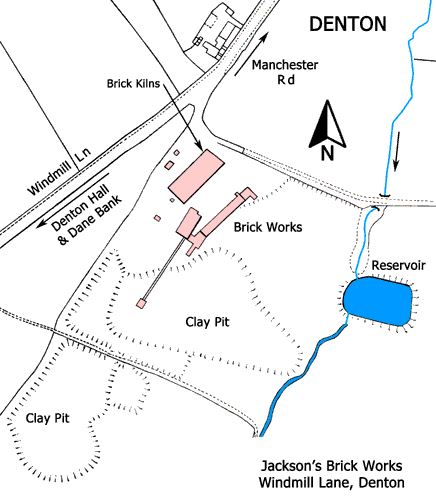
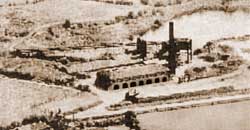
Jackson's Brick Works, Denton.
Preparation of Green Bricks
The preparation of clay at Denton done was at the back of the site adjacent to the clay pit. The raw clay was first crushed and mixed with breeze, which was powdered coal shale.
In some areas, breeze was either powdered coke, a waste product from gasworks, or powdered anthracite. Either way, the purpose of breeze was to reduce the amount of coal used and as an aid to firing.
This process was know as pug milling and the machine used was a pugmill, which in essence was a
large mincing machine incorporating a rotating screw fitted with blades whose purpose was to cut and knead the clay and, importantly, remove all the air trapped in the clay. The clay was first placed in a
hopper attached to the mill, which was then tamped to force it into the rotating screw. By the time that the clay had passed to the end of the mill it was perfectly smooth with an even texture and colour and
improved firing qualities. The clay was then extruded in a continuous strip through a rectangular aperture in the end of the pugmill onto a roller conveyer where it was wire sliced into brick-length blocks.
In both section and length a green brick was larger than the size of a finished brick to allow for shrinkage during drying and firing. Alternatively, for small batches, the clay would be put into moulds or
presses where it was formed into the required shape.
The green bricks then needed to be dried before they could be fired and this was usually done in special drying kilns. Alternatively, bricks could be placed in a drying shed where they dried naturally. The final stage was to fire the bricks in high-temperature kilns.
The temperature of the oxidation period ranged from around 150 to 980°C and the temperature of the vitrification period ranged from around 870 to 1,315°C.
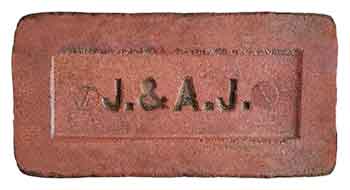
Brick manufactured by J & A Jackson Ltd.
Brick Kilns
The battery of kilns at Denton was at the front of the site facing Windmill Ln and they were intermittent or periodic kilns, each one consisting of a single firing chamber.
In use, a kiln was loaded with a batch of green bricks, which were then fired and allowed to cool before it was unloaded and made ready for use again. A cycle usually took about a week to complete.
Three types of kiln were commonly in use and these were:
It is the third type of kiln that was used at Jackson's Brick Works in Denton. The first type of kiln was inadequate for the large quantity of bricks that were being manufactured and second type of kilns were circular with a domed roof, known as beehive kilns.
Sunfield Brick Works, Manchester Rd, Denton, Lancashire
This brick works was situated off the south side of Manchester Rd nearly opposite the entrance to Denton Golf Club. The proprietors were James and Thomas Ludlow.
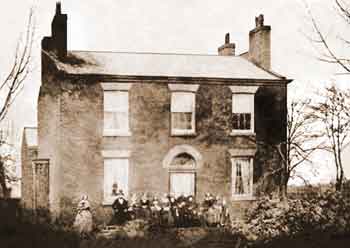
The Ludlow residence, Manchester Rd, 1890s.
By 1891 James Ludlow was resident on the south side of Manchester Rd, adjacent to the Sunfield Brick Works. In 1901 the residents were James Ludlow, his wife, Fanny Dixon, their children, and Septimus Horridge Ludlow, brother of James Ludlow. By 1911 his brother, Thomas Ludlow, was resident on Gorton Rd, Reddish, with his wife Amy Howarth Mottram.
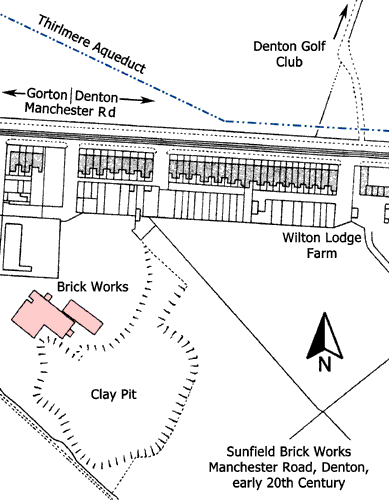
Thornley Ln Brick Works, Denton, Lancashire
This brick works was situated on Thornley Ln (North), about 410 yards to the south east of Ash Rd.
It was owned by M E Hall & Son who also owned another brick works on Taylor St, Gorton.